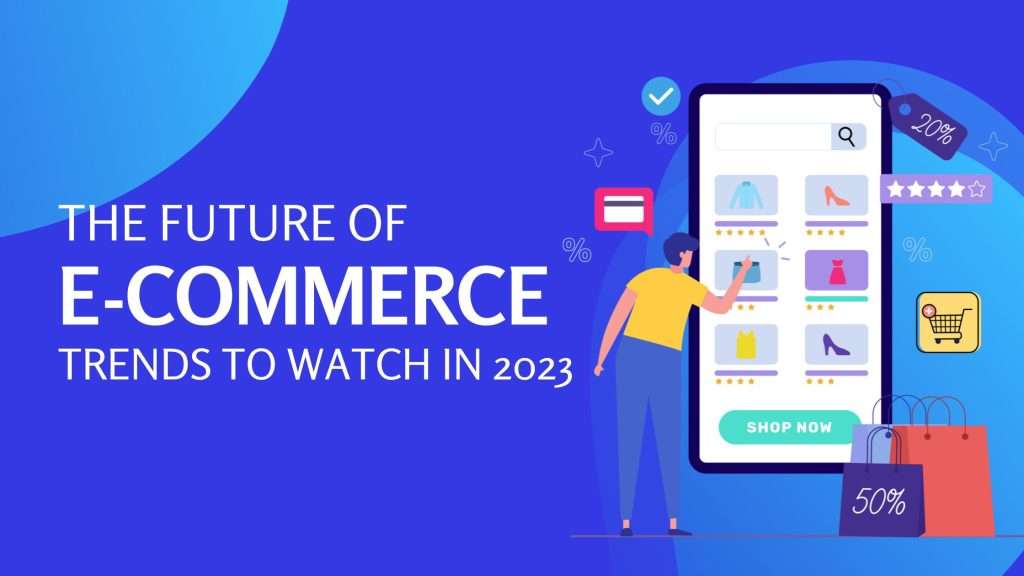Welcome to the future of e-commerce! As we step into 2023, the online shopping landscape is evolving at an unprecedented pace. From virtual reality-powered shopping experiences to drone deliveries and personalized AI assistants, there’s no denying that technology is reshaping the way we buy and sell goods. In this blog post, we will explore the most exciting trends that are set to revolutionize e-commerce in 2023 and beyond. So fasten your seatbelts as we take a thrilling ride through what lies ahead for online retail – get ready to be amazed by what’s on the horizon!
Introduction to the Growing Popularity of E-Commerce
E-commerce, or the buying and selling of goods and services online, has become a major player in the global economy. With technology advancing at a rapid pace, it is no surprise that the popularity of e-commerce is also on the rise. In fact, according to Statista, e-commerce sales are projected to reach $4.9 trillion by 2021.
One of the main reasons for the growing popularity of e-commerce is its convenience. With just a few clicks, consumers can purchase products from the comfort of their own home and have them delivered right to their doorstep. This eliminates the need to physically go to a brick-and-mortar store and wait in long lines at checkout counters.
Another factor contributing to the rise of e-commerce is its accessibility. With smartphones becoming an essential part of our daily lives, people now have access to online shopping platforms anytime and anywhere. This makes it easier for consumers to make purchases on-the-go and increases impulse buying.
Furthermore, e-commerce offers a wider variety of products compared to traditional retail stores. Consumers can find almost anything they need online – from clothing and electronics to groceries and even services such as travel bookings or food delivery. This allows for greater consumer choice and enables businesses to reach a larger audience.
In addition, many retailers have embraced e-commerce as a way to expand their business globally without having physical stores in different locations. E-commerce removes geographical barriers and allows businesses to sell their products internationally with ease.
Current Trends in E-Commerce
1. Current State of E-Commerce Industry:
The world of e-commerce has seen rapid growth in recent years, and it shows no signs of slowing down. According to Statista, global e-commerce sales are projected to reach $4.9 trillion by 2021, with an estimated 2.14 billion online shoppers worldwide.
2. Mobile Commerce is on the Rise:
One of the biggest trends in e-commerce is the increasing use of mobile devices for online shopping. With the rise of smartphones and tablets, more and more customers are choosing to make purchases on their mobile devices rather than traditional desktop computers. In fact, a study by Statista found that 72% of all e-commerce transactions will be made on a mobile device by 2021.
3. Personalization and Customization:
With so much competition in the e-commerce industry, companies are looking for ways to stand out and provide a unique shopping experience for their customers. This has led to a focus on personalization and customization, where businesses use customer data to tailor product recommendations, marketing messages, and even website layouts based on individual preferences.
4. Artificial Intelligence (AI) and Machine Learning:
AI technology is being integrated into various aspects of e-commerce, from chatbots that assist customers with inquiries to advanced algorithms that predict customer behavior and optimize pricing strategies. Machine learning allows businesses to analyze vast amounts of data quickly and accurately, providing valuable insights into consumer trends and preferences.

– Rise of Mobile Commerce
Mobile commerce, also known as m-commerce, has been steadily on the rise in recent years and is expected to continue its upward trajectory in the future. With the increasing use of smartphones and other mobile devices, consumers are now able to shop and make purchases anytime and anywhere. As a result, businesses across industries are shifting their focus towards optimizing their online presence for mobile devices.
One of the main driving forces behind the rise of mobile commerce is convenience. With just a few taps on their phone screens, consumers can easily browse through products, compare prices, and make purchases without having to leave their homes or offices. This convenience factor has made m-commerce a popular choice among busy individuals who have limited time for traditional shopping methods.
Another contributing factor to the growth of mobile commerce is the advancement of technology in terms of faster internet speeds and improved user experiences. With high-speed mobile data networks such as 4G and 5G becoming more widespread, consumers no longer have to wait for long loading times or deal with connectivity issues while shopping on their phones. Additionally, many businesses have invested in creating user-friendly mobile apps and websites that provide a seamless shopping experience for customers.
The COVID-19 pandemic has also played a significant role in accelerating the adoption of m-commerce. With lockdowns and restrictions worldwide limiting physical shopping options, consumers turned to online channels including mobile commerce for their everyday needs. This surge in demand for online shopping during the pandemic further highlighted the importance of having a strong mobile commerce strategy for businesses.
– Personalization and Artificial Intelligence
E-commerce has come a long way in the past few years, and it is constantly evolving to meet the changing needs and expectations of consumers. One of the major driving forces behind this evolution is the use of personalization and artificial intelligence (AI) in e-commerce. In fact, these two concepts are expected to play an even bigger role in shaping the future of e-commerce. Let’s take a deeper look at what personalization and AI mean for the world of online shopping.
Personalization in E-Commerce:
Personalization refers to tailoring a consumer’s experience based on their specific preferences, behaviors, and characteristics. With the rise of big data and advanced analytics tools, e-commerce businesses now have access to vast amounts of customer data that can be used to personalize their offerings.
One way that e-commerce businesses are using personalization is through targeted marketing strategies. By analyzing customer data such as browsing history, purchase history, demographics, and social media interactions, businesses can create personalized marketing campaigns that cater to each individual’s interests and needs.
Another aspect of personalization in e-commerce is product recommendations. Using algorithms based on customer data, personalized product recommendations can be shown on a website or app homepage or during checkout. This not only makes it easier for customers to find products they might be interested in but also increases the chances of making a sale by providing relevant suggestions.
– Social Media Shopping
Social media has become an integral part of our daily lives, and it’s no surprise that it has also revolutionized the way we shop. Social media shopping, or social commerce, is a growing trend in the e-commerce world that is changing the way businesses interact with their customers and sell their products.
What is Social Media Shopping?
Social media shopping refers to the process of buying products directly from social media platforms such as Facebook, Instagram, Pinterest, and Twitter. It eliminates the need for consumers to visit a separate website to make a purchase; instead, they can buy directly within their favorite social media app.
With the rise of influencer marketing and user-generated content on social media, consumers are increasingly turning to these platforms for product recommendations and reviews. This has made it easier for businesses to reach their target audience through targeted advertising and strategic partnerships with influencers.
The Rise of Shoppable Posts
One of the main ways social media shopping is facilitated is through shoppable posts. These are posts on social media platforms that have integrated product tags which allow users to click on them and be directed to a page where they can purchase the featured product.
Shoppable posts have become popular because they provide a seamless shopping experience for consumers without disrupting their browsing or scrolling on social media. They also allow businesses to showcase their products in an organic way rather than traditional intrusive advertisements.
Emerging Technologies and Their Impact on E-Commerce
The world of e-commerce is constantly evolving, and with new technologies emerging at a rapid pace, the landscape of online shopping is set to change even further. In this section, we will explore some of the most exciting technologies that are shaping the future of e-commerce and their potential impact on the industry.
1. Artificial Intelligence (AI):
Artificial intelligence has already made a significant impact in various industries, and it’s now starting to shape the world of e-commerce as well. AI-powered chatbots are being used by many online businesses to provide personalized customer service and enhance the overall shopping experience. These chatbots can handle basic customer inquiries, recommend products based on customer preferences, and even complete transactions without any human intervention.
Moreover, AI technology is also being used for product recommendations. By analyzing customers’ browsing behavior and purchase history, AI algorithms can suggest products that are most likely to be of interest to them. This not only improves the customer experience but also increases sales for businesses.
2. Augmented Reality (AR) and Virtual Reality (VR):
Augmented reality refers to overlaying digital images onto real-world environments, while virtual reality creates an entirely immersive digital environment for users. Both AR and VR have been gaining popularity in recent years, particularly in the retail sector.
Many e-commerce businesses have started using AR technology to allow customers to try out products virtually before making a purchase decision.
– Virtual and Augmented Reality
Virtual and Augmented Reality (VR/AR) are rapidly emerging technologies that have the potential to revolutionize the e-commerce industry. These technologies offer immersive, interactive experiences that can significantly enhance the customer shopping journey. According to research by Goldman Sachs, VR/AR is predicted to become an $80 billion market by 2025, with a significant portion of this growth coming from e-commerce.
So, what exactly are virtual and augmented reality? Virtual reality refers to a computer-generated simulation of a three-dimensional environment that can be interacted with in a seemingly real way through specialized equipment such as headsets or gloves. On the other hand, augmented reality involves overlaying digital content onto the real world using devices like smartphones or tablets.
One major advantage of VR/AR in e-commerce is its ability to bridge the gap between online and offline shopping experiences. With these technologies, customers can try on clothes virtually before making a purchase or see how furniture will look in their home without having to physically visit a store. This boosts convenience for shoppers while reducing returns and increasing overall satisfaction.
Moreover, VR/AR has immense potential for personalization in e-commerce. By creating virtual stores tailored to individual preferences and behaviors, brands can provide highly personalized shopping experiences for their customers. For instance, imagine browsing through an online store where products are displayed based on your past purchases or interests – this level of customization not only makes shopping more efficient but also enhances customer loyalty.
– Voice Commerce
With the rise of voice assistants such as Amazon’s Alexa, Google Assistant, and Apple’s Siri, voice commerce is quickly becoming the next big trend in e-commerce. Voice commerce refers to the process of using voice commands to make purchases through a smart speaker or other voice-enabled device.
The convenience and ease of use offered by voice commerce are what makes it so attractive to consumers. Instead of having to browse through websites or open multiple apps on their phones, users can simply speak their order out loud and have it delivered directly to their doorstep.
One of the key benefits of voice commerce is its ability to streamline the purchasing process. With traditional e-commerce, customers often have to go through several steps before making a purchase – from finding the product they want, adding it to their cart, and entering payment details. With voice commerce, however, these steps are significantly reduced. Users can simply tell their virtual assistant what they want and complete the transaction within seconds.
Another advantage of voice commerce is its potential for increased personalization. As more people use these devices in their homes on a daily basis, companies will have access to valuable data about consumer behavior and preferences. This data can be used to tailor personalized recommendations and offers based on individual shopping habits.
– Drones and Autonomous Delivery
The rise of e-commerce has led to an increasing demand for faster and more efficient delivery methods. This has given rise to the use of drones and autonomous vehicles for last-mile deliveries in the e-commerce industry.
Drones, also known as unmanned aerial vehicles (UAVs), have been used for military purposes for decades, but in recent years they have gained popularity in the commercial sector. With advancements in technology, drones are now able to carry packages weighing up to several pounds and deliver them directly to a customer’s doorstep.
One of the main advantages of using drones for delivery is their speed. Unlike traditional delivery methods which involve navigating through traffic and roadblocks, drones can fly directly from the distribution center to the customer’s location, cutting down delivery times significantly. This is particularly beneficial for urgent or time-sensitive deliveries.
Moreover, drone delivery can also be cost-effective. As they do not require a human driver or fuel costs, companies can save on labor and transportation expenses. This is especially beneficial for smaller businesses that may not have large budgets for shipping costs.
Another emerging trend in e-commerce delivery is the use of autonomous vehicles such as self-driving cars and trucks. These vehicles are equipped with sensors, cameras, and advanced software that allow them to navigate through roads and traffic without human intervention.
Autonomous vehicles offer similar benefits as drones when it comes to fast and efficient deliveries. They can operate 24/7 without rest breaks or limitations due to weather conditions.
The Future of E-Commerce: Predictions for 2023
The world of e-commerce has been rapidly evolving and expanding in recent years, with the COVID-19 pandemic only accelerating this growth. As we look towards the future, it is clear that e-commerce will continue to play a crucial role in shaping the way we shop and do business. In this section, we will explore some predictions for 2023 that will likely shape the future of e-commerce.
1. Increased Integration of Augmented Reality (AR) and Virtual Reality (VR)
The use of AR and VR technologies in the e-commerce industry is expected to see significant growth in the coming years. These technologies allow consumers to have a more immersive shopping experience by virtually trying on products or visualizing how furniture or home decor items would look in their space. This not only enhances customer engagement but also reduces product returns, as customers can make more informed purchasing decisions.
2. Rise of Voice Commerce
With the increasing popularity of virtual assistants like Amazon’s Alexa and Google Assistant, voice commerce is expected to become a major trend in 2023. Consumers can already use these devices to order products online, but advancements in natural language processing are expected to make voice-based shopping even more seamless and personalized.
3. Growth of Social Commerce
Social media platforms have become an important tool for businesses to reach potential customers and engage with their target audience. In 2023, social media platforms are predicted to further integrate with e-commerce through features such as “buy” buttons directly on posts or shoppable ads within users’
Conclusion
As we look towards the future of e-commerce, it is clear that technology will continue to play a major role in shaping the industry. From advancements in AI and virtual reality to the rise of social media shopping and personalized experiences, there are many exciting trends on the horizon. It is crucial for businesses to stay informed and adapt to these changes in order to remain competitive in this ever-evolving market. By keeping an eye on these emerging trends, we can anticipate what’s to come and prepare for a successful future in e-commerce.

